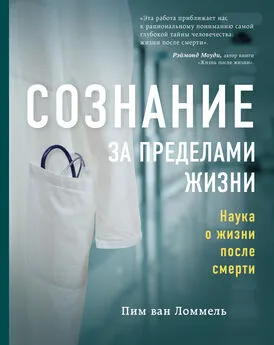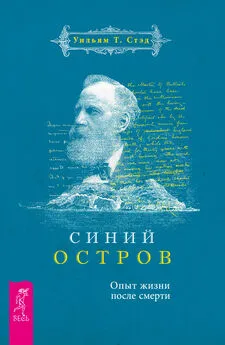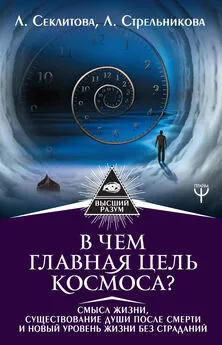Пим Ломмель - Сознание за пределами жизни. Наука о жизни после смерти
- Название:Сознание за пределами жизни. Наука о жизни после смерти
- Автор:
- Жанр:
- Издательство:Эксмо
- Год:2021
- Город:Москва
- ISBN:978-5-04-154586-4
- Рейтинг:
- Избранное:Добавить в избранное
-
Отзывы:
-
Ваша оценка:
Пим Ломмель - Сознание за пределами жизни. Наука о жизни после смерти краткое содержание
В формате PDF A4 сохранен издательский макет.
Сознание за пределами жизни. Наука о жизни после смерти - читать онлайн бесплатно ознакомительный отрывок
Интервал:
Закладка:
2. R. F. Hoffman, “Disclosure Habits After Near-Death Experience: Influences, Obstacles and Listeners Selection,” Journal of Near-Death Studies 14 (1995): 29–48.
3. K. Ring, Heading Toward Omega: In Search of the Meaning of the Near-Death Experience (New York: William Morrow, 1984).
4. P. van Lommel et al., “Near-Death Experiences in Survivors of Cardiac Arrest: A Prospective Study in the Netherlands,” Lancet 358 (2001): 2039–2045.
5. M. J. Sauve et al., “Patterns of Cognitive Recovery in Sudden Cardiac Arrest Survivors: The Pilot Study,” Heart Lung 25, no. 3 (1996): 172–181.
6. B. Greyson, “Incidence and Correlates of Near-Death Experiences in a Cardiac Care Unit,” General Hospital Psychiatry 25 (2003): 269–276.
7. Hoffman, “Disclosure Habits.”
8. Ring, Heading Toward Omega .
9. Американское исследование – Greyson, “Incidence and Correlates”; британское – Parnia et al., “Cardiac Arrest Survivors”; см. также: P. Sartori, “The Incidence and Phenomenology of Near-Death Experiences,” Network Review (Scientific and Medical Network) 90 (2006): 23–25.
10. Greyson, “Incidence and Correlates.”
11. Parnia et al, “Cardiac Arrest Survivors.”
12. M. B. Sabom, Recollections of Death: A Medical Investigation (New York: Harper & Row, 1982).
13. P. Sartori, P. Badham, and P. Fenwick, “A Prospectively Studied Near-Death Experience with Corroborated Out-of-Body Perception and Unexplained Healing,” Journal of Near-Death Studies 25, no. 2 (2006): 69–84.
1. P. van Lommel et al., “Near-Death Experiences in Survivors of Cardiac Arrest: A Prospective Study in the Netherlands,” Lancet 358 (2001): 2044.
2. B. Greyson, “Incidence and Correlates of Near-Death Experiences in a Cardiac Care Unit,” General Hospital Psychiatry 25 (2003): 275.
3. S. Parnia et al., “A Qualitative and Quantitative Study of the Incidence, Features and Aetiology of Near-Death Experiences in Cardiac Arrest Survivors,” Resuscitation 48 (2001): 151.
4. P. Sartori, “The Incidence and Phenomenology of Near-Death Experiences,” Network Review (Scientific and Medical Network) 90 (2006): 23–25.
5. S. Parnia and P. Fenwick, “Near-Death Experiences in Cardiac Arrest: Visions of a Dying Brain or Visions of a New Science of Consciousness. Review article,” Resuscitation 52 (2002): 5–11.
6. K. T. Gopalan et al., “Cerebral Blood Flow Velocity During Repeatedly Induced Ventricular Fibrillation,” Journal of Clinical Anesthesia 11, no. 4 (1999): 290–295.
7. J. Mayer and T. Marx, “The Pathogenesis of EEG Changes During Cerebral Anoxia,” в кн.: Cardiac and Vascular Diseases/Handbook of Electroencephalography and Clinical Neurophysiology , ed. J. H. A. van der Drift (Amsterdam: Elsevier, 1972), vol. 14A, pt. A, pp. 5–11.
8. Parnia and Fenwick, “Near-Death Experiences in Cardiac Arrest”; J. W. de Vries et al., “Changes in Cerebral Oxygen Uptake and Cerebral Electrical Activity During Defibrillation Threshold Testing,” Anesthesia Analgesia 87 (1998): 16–20; H. Clute and W. J. Levy, “Electroencephalographic Changes During Brief Cardiac Arrest in Humans,” Anesthesiology 73 (1990): 821–825; T. J. Losasso et al., “Electroencephalographic Monitoring of Cerebral Function During Asystole and Successful Cardiopulmonary Resuscitation,” Anesthesia Analgesia 75 (1992): 12–19.
9. N. M. Branston et al., “Comparison of the Effects of Ischaemia on Early Components of the Somatosensory Evoked Potential in Brainstem, Thalamus, and Cerebral Cortex,” Journal of Cerebral Blood Flow Metabolism 4, no. 1 (1984): 68–81; J. Gua, J. A. White, and H. H. Batjer, “Limited Protective Effects of Etomidate During Brainstem Ischemia in Dogs,” Journal of Neurosurgery 82, no. 2 (1995): 278–284.
10. D. S. Smith et al., “Reperfusion Hyperoxia in the Brain After Circulatory Arrest in Humans,” Anesthesiology 73 (1990): 12–19.
11. Mayer and Marx, “Cerebral Anoxia”; G. Buunk, J. G. van der Hoeven, and A. E. Meinders, “Cerebral Blood Flow After Cardiac Arrest,” Netherlands Journal of Medicine 57 (2000): 106–112; Losasso et al., “Electroencephalographic Monitoring.”
12. E. D. Kelly and E. W. Kelly, “Unusual Experiences Near Death and Related Phenomena,” chap. 6, в кн: Irreducible Mind: Toward a Psychology for the 21 st Century (Lanham, MD: Rowman & Littlefield, 2007), 418.
13. M. J. Sauve et al., “Patterns of Cognitive Recovery in Sudden Cardiac Arrest Survivors: The Pilot Study,” Heart Lung 25, no. 3 (1996): 172–181.
14. M. Fujioka et al., “Hippocampal Damage in the Human Brain After Cardiac Arrest,” Cerebrovascular Diseases 10, no. 1 (2000): 2–7; H. C. Kinney et al., “Neuropathological Findings in the Brain of Karen Ann Quinlan: The Role of the Thalamus in the Persistent Vegetative State,” New England Journal of Medicine 330, no. 26 (1994): 1469–1475.
15. G. W. van Dijk, “Bewustzijn” [Сознание], в кн.: Handboek Reanimatie [Пособие по реанимации], 2 ndrev. ed., ed. B. T. J. Meursing and R. G. van Kesteren (Utrecht, the Netherlands: Wetenschappelijke Uitgeverij Bunge, 2004), 21–25.
16. Van Dijk, “Bewustzijn” [Сознание].
17. Van Dijk, “Bewustzijn” [Сознание].
18. J. Herlitz et al., “Characteristics and Outcome Among Patients Suffering from In-Hospital Cardiac Arrest in Relation to the Interval Between Collapse and Start of CPR,” Resuscitation 53, no. 1 (2000): 21–27.
19. N. A. Paradis, G. B. Martin, and M. G. Goetting, “Simultaneous Aortic Jugular Bulb, and Right Atrial Pressures During Cardiopulmonary Resuscitation in Humans: Insights into Mechanisms,” Circulation 80 (1989): 361–368; N. A. Paradis, G. B. Martin, and J. Rosenberg, “The Effect of Standard and High Dose Epinephrine on Coronary Perfusion Pressure During Prolonged Cardiopulmonary Resuscitation,” Journal of the American Medical Association 265 (1991): 1139–1144.
20. Clute and Levy, “Electroencephalographic Changes”; Losasso et al., “Electroencephalographic Monitoring”; K. A. Hossmann and P. Kleihues, “Reversibility of Ischemic Brain Damage,” Archives of Neurology 29, no. 6 (1973): 375–384; J. Moss and M. Rockoff, “EEG Monitoring During Cardiac Arrest and Resuscitation,” Journal of American Medical Association 244, no. 24 (1980): 2750–2751.
21. P. Safar et al., “Cerebral Resuscitation Potentials for Cardiac Arrest,” Critical Care Medicine 30, no. 4, suppl. (2002): 140–144.
22. C. G. Coimbra, “Implications of Ischemic Penumbra for the Diagnosis of Brain Death,” Brazilian Journal of Medical and Biological Research 32, no. 12 (1999): 1479–1487.
23. M. B. Sabom, “Death: Defining the Final Frontier: The Case of Pam Reynolds,” Light and Death: One Doctor’s Fascinating Account of Near-Death Experiences (Grand Rapids, MI: Zondervan, 1998), 37–52.
24. H. Ebert, “Deep Hypothermia and Circulatory Arrest for Surgery of Complex Intracranial Aneurysms,” European Journal of Cardiothoracic Surgery 13, no. 3 (1998): 223–229.
1. J. E. Desmedt and D. Robertson, “Differential Enhancement of Early and Late Components of the Cerebral Somatosensory Evoked Potentials During Forced-Paced Cognitive Tasks in Man,” Journal of Physiology 271 (1977): 761–782; P. E. Roland and L. Friberg, “Localization in Cortical Areas Activated by Thinking,” Journal of Neurophysiology 53 (1985): 1219–1243; J. C. Eccles, “The Effect of Silent Thinking on the Cerebral Cortex,” Truth Journal: International Interdisciplinary Journal of Christian Thought 2 (1988); P. E. Roland, “Somatotopical Tuning of Postcentral Gyrus During Focal Attention in Man: A Regional Cerebral Blood Flow Study,” Journal of Neurophysiology 46 (1981): 744–754.
2. G. W. van Dijk, “Bewustzijn” [Сознание], в кн.: Handboek Reanimatie [Пособие по реанимации], 2 ndrev. ed., ed. B. T. J. Meursing and R. G. van Kesteren (Utrecht, the Netherlands: Wetenschappelijke Uitgeverij Bunge, 2004), 21–25.
3. C. Koch, “The Movie in Your Head,” Scientific American Mind 16, no. 3 (2005): 8–63; J. M. Schwartz and S. Begley, The Mind and the Brain: Neuroplasticity and the Power of Mental Force (New York: HarperCollins, 2002); D. Dobbs, “Fact or Phrenology?” Scientific American Mind 16, no. 1 (2005): 24–31.
4. M. Slob, интервью: “Waar de wetenschap niet bij kan” [Там, куда не достигает наука], NRC Handelsblad (January 20, 2007), образовательное и научное дополнение.
5. A. I. Jack and A. Roepstorff, “Introspection and Cognitive Brain Mapping: From Stimulus-Response to Script Report,” Trends in Cognitive Science 6, no. 8 (2002): 333–339; A. I. Jack and A. Roepstorff, “Why Trust the Subject?” Journal of Consciousness Studies 10, nos. 9–10 (2003): v – xx.
6. Jack and Roepstorff, “Introspection”; Jack and Roepstorff, “Why Trust the Subject?”
7. A. Freeman, “The Conscious Brain,” chap. 4, в кн.: Consciousness: A Guide to the Debates (Santa Barbara: ABC–CLIO, 2003), 61–80.
8. A. Noë, Out of Our Heads: Why You Are Not Your Brain, and Other Lessons from the Biology of Consciousness (New York: Hill and Wang, 2009).
9. J. L. Saver and J. Rabin, “The Neural Substrates of Religious Experience,” Journal of Neuropsychiatry 9, no. 3 (1997): 498–510.
10. Schwartz and Begley, Mind and the Brain , 18, 28.
11. H. Romijn, “About the Origin of Consciousness: A New, Multidisciplinary Perspective on the Relationship Between Brain and Mind,” Proceedings of the Koninklijke Nederlandse Akademie van Wetenschappen 100, nos. 1–2 (1997): 181–267.
12. Электрические заряды – потенциалы действия по обе стороны клеточной мембраны нейронов, вызванные кратковременным и быстрым изменением напряжения ввиду ионного обмена.
13. G. M. Edelman and G. Tononi, A Universe of Consciousness (New York: Basic Books, 2000).
14. Передача информации по нейронам осуществляется посредством потенциалов действий (временных изменений напряжения), вызванных разницей мембранного потенциала (различием электрического заряда или напряжения по разные стороны клеточной мембраны) ввиду их снижения (деполяризации) или роста (гиперполяризации) во многих местах контакта (синапсах) с другими нейронами. Этот процесс способствует выбросу нейромедиаторов в синапсах. Совокупность всех изменений мембранных потенциалов вызывает появление постоянно меняющихся электрических полей.
Читать дальшеИнтервал:
Закладка:









